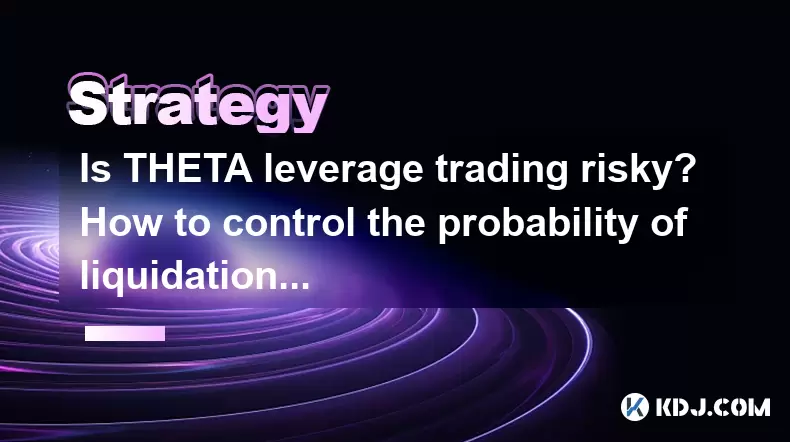-
 bitcoin
bitcoin $121833.232455 USD
-0.63% -
 ethereum
ethereum $4394.437030 USD
-2.00% -
 tether
tether $1.000570 USD
0.04% -
 bnb
bnb $1255.553465 USD
-3.73% -
 xrp
xrp $2.814944 USD
-1.59% -
 solana
solana $221.835346 USD
-2.40% -
 usd-coin
usd-coin $0.999869 USD
0.01% -
 dogecoin
dogecoin $0.249495 USD
-1.32% -
 tron
tron $0.336905 USD
-1.24% -
 cardano
cardano $0.816464 USD
-1.69% -
 chainlink
chainlink $22.130946 USD
-1.27% -
 hyperliquid
hyperliquid $44.208522 USD
-3.46% -
 ethena-usde
ethena-usde $1.000521 USD
0.02% -
 sui
sui $3.422897 USD
-2.51% -
 stellar
stellar $0.380164 USD
-1.31%
Is THETA leverage trading risky? How to control the probability of liquidation?
Leverage trading THETA can amplify returns but increases liquidation risk; use lower leverage and stop-loss orders to manage this risk effectively.
May 07, 2025 at 01:42 pm

Introduction to THETA Leverage Trading
Leverage trading in the cryptocurrency market, including with tokens like THETA, can be a powerful tool for traders looking to amplify their potential returns. However, it also comes with increased risks, particularly the risk of liquidation. Understanding these risks and learning how to manage them is crucial for anyone engaging in leverage trading.
Understanding the Risks of THETA Leverage Trading
THETA leverage trading involves borrowing funds to trade larger positions than one's initial capital would allow. This can lead to significant profits if the market moves in your favor, but it can also result in substantial losses if the market moves against you. The primary risk associated with leverage trading is liquidation, where a trader's position is forcibly closed by the exchange to prevent further losses when the account's equity falls below the maintenance margin.
Factors Contributing to the Risk of Liquidation
Several factors can increase the likelihood of liquidation when trading THETA with leverage:
- Market Volatility: The cryptocurrency market, including THETA, is known for its high volatility. Rapid price movements can quickly move a leveraged position into a loss, triggering liquidation.
- Leverage Ratio: The higher the leverage used, the smaller the price movement needed to trigger liquidation. For example, using 100x leverage means a 1% move against your position could result in liquidation.
- Position Size: Larger positions relative to the account balance increase the risk of liquidation, as they require more significant price movements to remain profitable.
- Maintenance Margin: Each exchange sets a maintenance margin requirement, which is the minimum amount of equity that must be maintained in the account. If the account balance falls below this level, the position is liquidated.
Strategies to Control the Probability of Liquidation
To manage the risk of liquidation when trading THETA with leverage, traders can employ several strategies:
- Use Lower Leverage: Opting for lower leverage ratios, such as 2x or 5x, reduces the risk of liquidation as it requires larger price movements to trigger it.
- Set Stop-Loss Orders: Placing stop-loss orders can help limit losses and prevent liquidation by automatically closing the position if the price reaches a certain level.
- Monitor Positions Closely: Keeping a close eye on open positions and market conditions allows traders to react quickly to adverse movements and adjust their strategies accordingly.
- Diversify: Spreading investments across different assets can reduce the impact of a single asset's volatility on the overall portfolio, thereby lowering the risk of liquidation.
- Use Risk Management Tools: Many exchanges offer tools like trailing stops and take-profit orders that can help manage risk and prevent liquidation.
Practical Steps to Implement These Strategies
Implementing the above strategies requires careful planning and execution. Here are detailed steps to help traders apply these strategies effectively:
Choosing the Right Leverage:
- Determine your risk tolerance and trading goals.
- Select a leverage ratio that aligns with your risk profile. For example, if you are risk-averse, opt for 2x or 3x leverage.
- Adjust the leverage based on the volatility of THETA and market conditions.
Setting Up Stop-Loss Orders:
- Log into your trading platform.
- Navigate to the THETA trading pair.
- Open a new position with the desired leverage.
- Set a stop-loss order at a price level that you are comfortable with. For example, if you buy THETA at $1.00, you might set a stop-loss at $0.95 to limit potential losses.
Monitoring Positions:
- Use trading platforms that offer real-time market data and position tracking.
- Set up alerts for significant price movements or when your position approaches the liquidation level.
- Regularly review your positions and adjust your strategy based on current market conditions.
Diversifying Your Portfolio:
- Allocate your capital across different cryptocurrencies, not just THETA.
- Consider investing in less volatile assets to balance the risk from high-volatility assets like THETA.
- Rebalance your portfolio periodically to maintain your desired risk level.
Utilizing Risk Management Tools:
- Familiarize yourself with the risk management tools offered by your trading platform.
- Set up trailing stop orders to lock in profits as the price moves in your favor.
- Use take-profit orders to automatically close positions when they reach your target profit level.
Understanding the Impact of Market Conditions on Liquidation Risk
Market conditions play a significant role in the risk of liquidation when trading THETA with leverage. During periods of high volatility, the risk of liquidation increases as prices can move rapidly. Conversely, in stable market conditions, the risk of liquidation is lower. Traders need to be aware of these dynamics and adjust their strategies accordingly.
Case Studies of THETA Leverage Trading
Examining real-life examples can provide valuable insights into the risks and management of leverage trading with THETA. For instance, consider a trader who uses 10x leverage to buy THETA at $1.00. If the price drops to $0.91, the trader's position would be liquidated, resulting in a total loss of the initial investment. By contrast, a trader using 2x leverage in the same scenario would have more room for price movement before reaching the liquidation point.
Frequently Asked Questions
Q: Can using leverage on THETA increase my potential returns?A: Yes, using leverage can amplify your potential returns if the market moves in your favor. However, it also increases the risk of significant losses, including the possibility of liquidation.
Q: What is the best leverage ratio to use when trading THETA?A: The best leverage ratio depends on your risk tolerance and trading strategy. Generally, lower leverage ratios (2x to 5x) are safer and reduce the risk of liquidation, while higher leverage ratios (10x and above) can offer higher potential returns but also come with increased risk.
Q: How can I quickly adjust my leverage if market conditions change?A: Most trading platforms allow you to adjust your leverage on open positions. To do this, log into your trading platform, navigate to your open positions, and select the option to modify the leverage. Be aware that changing leverage on an existing position may require closing and reopening the position, which could incur additional fees and affect your entry price.
Q: Is it possible to avoid liquidation entirely when trading THETA with leverage?A: While it is challenging to avoid liquidation entirely, you can minimize the risk by using lower leverage, setting stop-loss orders, closely monitoring your positions, and diversifying your portfolio. However, even with these measures, there is always a risk of liquidation in leveraged trading.
Disclaimer:info@kdj.com
The information provided is not trading advice. kdj.com does not assume any responsibility for any investments made based on the information provided in this article. Cryptocurrencies are highly volatile and it is highly recommended that you invest with caution after thorough research!
If you believe that the content used on this website infringes your copyright, please contact us immediately (info@kdj.com) and we will delete it promptly.
- Antalpha, Financing, and Tether Gold: A New York Perspective on the Digital Gold Rush
- 2025-10-10 20:45:16
- BlockDAG, Formula 1, and Mining: A Fast Track to Crypto Success?
- 2025-10-10 21:05:17
- Altcoin Season Fuel Flow: $5.95B Injects Optimism Amidst Digitap's Rise
- 2025-10-10 20:25:17
- Financing, Treasury, and Wealth Signs: Decoding the Latest Moves in the Crypto and Digital Asset Space
- 2025-10-10 20:45:16
- Pi Network, Story Protocol, BlockDAG F1: Crypto's Latest Buzz
- 2025-10-10 20:50:01
- Zcash, Privacy Coins, and Surveillance: A New Era of Anonymity?
- 2025-10-10 20:25:17
Related knowledge

Practical parameter settings for a Bitcoin multi-timeframe moving average system
Sep 18,2025 at 10:54pm
Optimizing Timeframe Combinations for Bitcoin Trading1. Selecting appropriate timeframes is crucial when building a multi-timeframe moving average sys...

How can I filter out false breakouts in Dogecoin high-frequency trading?
Sep 22,2025 at 01:00am
Understanding False Breakouts in Dogecoin Trading1. A false breakout occurs when Dogecoin's price appears to move beyond a defined support or resistan...

Techniques for identifying tops and bottoms in the Bitcoin on-chain NVT model
Sep 20,2025 at 07:54pm
Understanding the NVT Model in Bitcoin Analysis1. The Network Value to Transactions (NVT) ratio is often described as the 'P/E ratio' of the cryptocur...

What does the surge in open interest in Bitcoincoin futures mean?
Sep 20,2025 at 11:18pm
Understanding the Surge in Dogecoin Futures Open Interest1. A surge in open interest within Dogecoin futures indicates a growing number of active cont...

How can I use the Ethereum USDT premium to gauge market sentiment?
Sep 18,2025 at 11:55pm
Understanding the Ethereum USDT Premium1. The Ethereum USDT premium refers to the price difference between USDT (Tether) traded on Ethereum-based plat...

What should I do if Ethereum staking yields decline?
Sep 20,2025 at 06:18am
Understanding the Causes Behind Declining Ethereum Staking Yields1. The Ethereum network transitioned to a proof-of-stake consensus mechanism with the...

Practical parameter settings for a Bitcoin multi-timeframe moving average system
Sep 18,2025 at 10:54pm
Optimizing Timeframe Combinations for Bitcoin Trading1. Selecting appropriate timeframes is crucial when building a multi-timeframe moving average sys...

How can I filter out false breakouts in Dogecoin high-frequency trading?
Sep 22,2025 at 01:00am
Understanding False Breakouts in Dogecoin Trading1. A false breakout occurs when Dogecoin's price appears to move beyond a defined support or resistan...

Techniques for identifying tops and bottoms in the Bitcoin on-chain NVT model
Sep 20,2025 at 07:54pm
Understanding the NVT Model in Bitcoin Analysis1. The Network Value to Transactions (NVT) ratio is often described as the 'P/E ratio' of the cryptocur...

What does the surge in open interest in Bitcoincoin futures mean?
Sep 20,2025 at 11:18pm
Understanding the Surge in Dogecoin Futures Open Interest1. A surge in open interest within Dogecoin futures indicates a growing number of active cont...

How can I use the Ethereum USDT premium to gauge market sentiment?
Sep 18,2025 at 11:55pm
Understanding the Ethereum USDT Premium1. The Ethereum USDT premium refers to the price difference between USDT (Tether) traded on Ethereum-based plat...

What should I do if Ethereum staking yields decline?
Sep 20,2025 at 06:18am
Understanding the Causes Behind Declining Ethereum Staking Yields1. The Ethereum network transitioned to a proof-of-stake consensus mechanism with the...
See all articles










































































